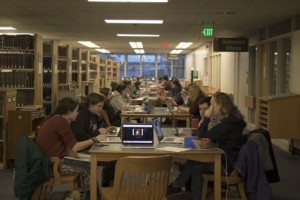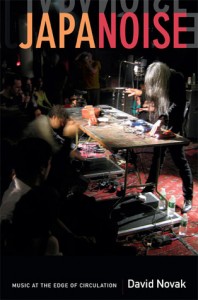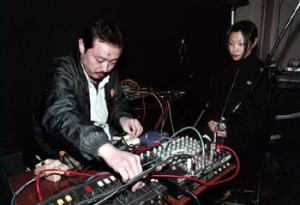Images from:
The Vermont Cynic
“Adventures in Vermont, Part Two.” The Desk Set Adventures in Vermont Part Two Comments. Web. 16 Dec. 2015.
Essay:
Michael Greenberg, Zach Bochicchio, Tess Neubauer
It is important to note that the sounds captured in our soundscape composition do not accurately reflect the sounds experienced by an actual person in the library. As Lawrence English describes, “Being non-cognitive, the microphone lacks an ability to focus in on particular sounds of interest and, more importantly, to filter out undesirable sonic materials.” (English). A soundscape recording is insufficient in its attempt to capture all the sounds experienced in a given environment, so it is highly recommended to visit each floor of the library in person to fully understand the following descriptions.
Sound is one of the most important senses that let the mind know what is going on around it, but it is also so much more than that. It defines a place. It defines the culture of that place and the people in it. Without sound, what we know about our surroundings would be dull, and void of the deeper understanding of our environments that only sound can bring. The first floor of the library is unlike any other place. It is a unique combination of various sounds, all which hold significant value independently, that together make up its soundscape.
The first floor serves as the meeting place for academics, friends, peers, and so many other diverse relationships. This is the floor that the soundscape recording begins with. As the recording progresses, the sounds move from the first floor to the second, and finally to the third. It serves as a place for ideas to be swapped and group projects to be completed. What separates the first floor from the other two is the bustle. The second and third floors serve as silent escapes from the busy lives that students live. Here, on the upper floors, are places to study and focus without the commotion of the first floor. The dominating sound of the first floor is the conversation, whether it is about school, or just friends catching up. Conversation is often higher pitched and has a longer duration than other sounds. Some other more subtle sounds are the sounds of the cafe: beeping and buzzing, the gurgling on the coffee machines pumping out coffee, or food being prepared. This is where the two sounds seem to split into a few different categories, either human or machine in origin. The sounds in the library fall into these two categories, and the first floor has the most prominent split between the two. The first floor has coffee machines, printers, computers, televisions, and so many other unnatural producers of sound. The first floor also has the highest output of human sound between quiet whispers, loud talking, laughing, sneezing, or coughing.
The library’s second floor is somewhat of a happy medium between the dead silence of the third floor and the comparatively bustling scene of the first floor. The second floor exists as a floor that is meant to be very quiet as so that studying can be interrupted with as few distractions as possible. Signs are posted to let students know that this is a quiet floor. Though most distractions are eliminated, some key sounds are not. The main sound heard throughout the second floor is the sound of typing. Short fast bursts of sounds. Little tics that vary very little in duration. Usually there is a burst of somewhat equi- tempo clicks that then stop. Presumably after the person has finished writing their phrase. Clicks do however vary in volume. Usually the spacebar is hit louder than the other keys. Similarly, the first and last clicks of a writing burst are usually the loudest while the notes in the middle seem to stay relatively similar in volume. Most students bring their laptops to the second floor for whatever purpose. The distinct sound of typing can always be heard throughout the library. The typing is an important sound to the second floor for its ability to imprint the drive of production on other students who are listening; intentionally or not. By hearing other students get work done, it makes you want to get work done as well. The point of going up to the second floor is productivity, and this sound produces exactly that. One of the other important sounds of the library is the sound of the chairs being moved. The load of work placed upon a college student can seem daunting and overwhelming. The sound of a student’s chair moving as they exit the library serves, similarly to the typing, as a beacon of light. Hope that there is an end to the work and a burst of energy to help get you working again as you close in on finishing whatever task you are trying to complete. The silence, or attempt at it, is the main reason that the second floor becomes such a productive place.
Interestingly, while trying to capture our soundscape, an issue came up within the recording of the second floor that we ultimately loved. As stated before, we think that in order to experience the true soundscape of an atmosphere, one must visit the location itself. Despite efforts by sound scholars like Monacchi to counter this belief, and recreate a soundscape almost identically, it is still the case that nothing will be quite like listening in person. As the recording of the second floor progresses, we can hear the recorder stepping. This is the predominant sound of the middle section of our piece, in fact. This is part of the concept of trying to capture a sound environment completely. The recorder himself will alter the soundscape, leading to some issues. Ultimately we found this valuable and worthy of keeping in the recording. The concept was to allow the listener to become conscious of the recorder themselves, and become aware that this sonic environment that they are listening to through headphones or speakers is, in a sense, artificial. The silence we recorded on the second floor is undoubtedly a huge shift from the first floor, however; the third floor was the most quiet of them all.
The third floor is somewhat of an anomaly. So much is going on on this floor, but so little sound is produced. It such a unique experience being on a floor that contains such a sharp difference between the internal actions of everyone there and the external energy produced. Everyone there is trying to get as much work done, doing so much activity in absolute silence, save for a few occasional sneezes, coughs, or typing on the computer. The dominating sound here is the absence of sound. The first thing that someone notices on the third floor is that there is a lack of dominating sounds. Rather, there are several keynote sounds that the person listening tunes out because of such intense focus; they are only heard the you stop and listen for a few moments. These sounds include the constant high-pitched buzzing of the lights, the typing of people’s computers, the coughing or deep breathing of an anxious student. It takes a trained ear to take a step back and understand all of these sounds. As Schafer describes, “The ear’s only protection is an elaborate psychological mechanism for filtering out undesirable sound in order to concentrate on what is desirable” (Schafer 103). Schafer clearly highlights the fact that the people on the third utilize the psychological mechanism to filter out the sounds that would distract them from their studies. This is the most magical thing about the third floor silence. It is an amazing culmination of people drowning out everyone else, consciously choosing not to hear anything but the teachings swirling around in their heads, each person too focused to care about anything else. We believe, as a group, that our soundscape composition accurately reflects the themes and different soundscapes of each floor.
We found that on the first floor, the bustling and chatty atmosphere led to a feeling of comradery and unity. There was a sense of many students working together academically and otherwise in order to achieve a common goal. Upon traveling to the second floor, though, the atmosphere shifts, primarily due to the absence of sounds. This gives a sense of productivity, with even a strange tinge of stress in the air. The few noises in the background blend together in a way that create an academic environment. The third floor does much of the same. The silence, to some, is jarring. To others, comforting. Regardless, the absence of sound is the most noticeable.
Overall, this soundscape composition is a tiny glimpse into the complex sounds that make up the library. Each sound was chosen to represent either a human or mechanical origin, and each sound being so important to the soundscape of the library as a whole and on each level. This composition reflects the things that we’ve learned in this course, and come to appreciate as a deeper understanding of the world around us, both acoustically, and not.




